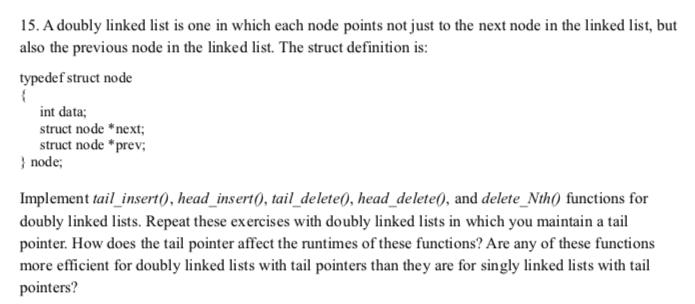Question
15. A doubly linked list is one in which each node points not just to the next node in the linked list, but also

15. A doubly linked list is one in which each node points not just to the next node in the linked list, but also the previous node in the linked list. The struct definition is: typedef struct node int data; struct node *next; struct node *prev; node; Implement tail_insert(), head_insert(), tail_delete(), head_delete(), and delete Nth() functions for doubly linked lists. Repeat these exercises with doubly linked lists in which you maintain a tail pointer. How does the tail pointer affect the runtimes of these functions? Are any of these functions more efficient for doubly linked lists with tail pointers than they are for singly linked lists with tail pointers?
Step by Step Solution
There are 3 Steps involved in it
Step: 1

Get Instant Access to Expert-Tailored Solutions
See step-by-step solutions with expert insights and AI powered tools for academic success
Step: 2

Step: 3

Ace Your Homework with AI
Get the answers you need in no time with our AI-driven, step-by-step assistance
Get StartedRecommended Textbook for
Practical Introduction To Data Structures And Algorithm Analysis Java Edition
Authors: Clifford A. Shaffer
1st Edition
0136609112, 978-0136609117
Students also viewed these Computer Network questions
Question
Answered: 1 week ago
Question
Answered: 1 week ago
Question
Answered: 1 week ago
Question
Answered: 1 week ago
Question
Answered: 1 week ago
Question
Answered: 1 week ago
Question
Answered: 1 week ago
Question
Answered: 1 week ago
Question
Answered: 1 week ago
Question
Answered: 1 week ago
Question
Answered: 1 week ago
Question
Answered: 1 week ago
Question
Answered: 1 week ago
Question
Answered: 1 week ago
Question
Answered: 1 week ago
Question
Answered: 1 week ago
Question
Answered: 1 week ago
Question
Answered: 1 week ago
Question
Answered: 1 week ago
View Answer in SolutionInn App



